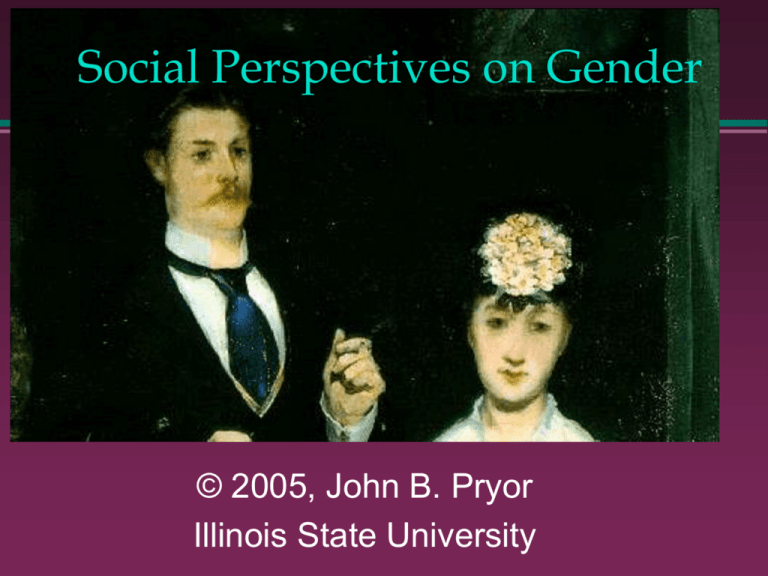Social Perspectives on Gender - the Department of Psychology at
advertisement

Social Perspectives on Gender © 2005, John B. Pryor Illinois State University Gender Stereotypes Broverman et a. (1972) Competency cluster: aggressive, direct, independent, active, not emotional, objective, worldly, logical, dominant, acts as a leader, never cries warmthexpressiveness cluster: gentle, tactful, quite, religious, neat, aware of others’ feelings, easily expresses tender feelings, enjoys art & literature, need for security Describe a healthy, mature, sociallly competent a) male, b) female, or c) adult (sex unspecified) Healthy women are expected to be less: independent adventurous aggressive competitive Healthy women are expected to be more: submissive easily influenced excitable in minor crises conceited about their appearance from Broverman, et al. Consequences of stereotypes at work Ideal managers are described as more male-like (women no longer believe this in the U.S.) Stereotypes of people who earn more money involve strong increases in positive male qualities (e.g., independence) moderate increases in negative male qualities (e.g., aggressiveness) and overall decreases in female qualities Employees question the competency of female managers Female leaders receive more negative non-verbal cues from groups members than men Leadership Styles of Women and Men From Eagly, Johannesen-Schmidt, & Engen (2003) •Women are more likely than men to be TRANFORMATIONAL LEADERS -Transformational leaders communicate values, purpose, and importance of organization’s mission -Transformational leaders exhibit optimism & excitement about goals -Transformational leaders examine new perspectives for solving problems -Transformational leaders focus on the development and mentoring of followers •Men are more likely than women to be TRANSACTIONAL or LAISSEZ-FARE LEADERS 19 51 19 53 19 55 19 57 19 59 19 61 19 63 19 65 19 67 19 69 19 71 19 73 19 75 19 77 19 79 19 81 19 83 19 85 19 87 19 89 19 91 19 93 19 95 19 97 19 99 20 01 20 03 Percent Women's Earning in the US as a Percent of Men's Earnings 90 80 70 60 50 40 30 20 10 0 Year countries tu ga l 89 Po r 88 It al y lg iu m 87 Be e 86 Fr an c 83 ec e 82 re 81 86 G 90 Sp ai n g Sw ed en D en m ar k em bo ur 81 Lu x m an y er 79 G 79 Fi nl an d rla nd s 78 he ria ng do m el an d at es Au st Ki Ir St 75.5 78 N et ni te d d ni te percent 80 U U Gender Wage Gap Comparing USA to Selected European Countries 100 91 95 70 60 50 40 30 20 10 0 Reasons women expect lower salaries Women expect to take more time off work (e.g. for child rearing) Women place less importance on job outcomes than men Women earn less in reality Women have lower self-confidence in many achievement situations Stereotypes are maintained even when the evidence is conflicting. Research by Deaux Weiner’s Taxonomy ATTRIBUTIONS ABOUT PERFORMANCE INTERNAL EXTERNAL TEMPORAR Y EFFORT LUCK STABLE ABILITY TASK DIFFICULTY Why do women fail? Why do women succeed? Why do men fail? Why do men succeed? “He’s skilled, she’s lucky” Swim & Sanna, 1996 Women generally do not score as high as men on standardized tests of math and science competence. Why? The Performance of Women on MasculineTasks is Influenced by Stereotype Threat Stereotype Threat is being concerned about a negative stereotype of your group. For example, women might be concerned about the stereotype that women are inferior in math. This concern can lead to distress and distraction when stereotypes are thought to be relevant to performance This distress can interfere with performance Some women are more conscious of group membership (I.e., being a woman) than others Schmader (2003) Male & Female college students selected who scored 500-700 on quantitative part of SAT Measured Collective Self-Esteem: e.g., “Being a woman/man is an important part of my selfimage.” Participants told either that their scores on a test would be compared to other students or that males and females would be compared-Gender Relevance Manipulation Participants took math section of GRE Gender Identification as a Moderator of Gender Identity Relevance Effects on Women's and Men's Math Performance (Schmader, Only significant Male/female difference 7 Math Test Performance 6 5 4 Low Identified High Identified 3 2 1 0 Men Women Gender Identity Not Relevant Men Women Gender Identity Relevant What are the actual gender differences in social behavior? Eagly & Wood (1991) Nine sex differences in adults observed across many studies: 1. Women are better at sending and receiving messages nonverbally. 2. Women conform to group pressure more than men. 3. Women act more friendly and agree more with other group members in small groups. Eagly & Wood (1991) 4. Men are more strictly task-oriented in work groups. 5. All female groups typically perform better than all male groups. 6. Men are more likely to emerge as leaders in initially leaderless groups. Eagly & Wood (1991) 7. Men are more helpful in short-term interactions with strangers. 8. Men behave more aggressively to others than women, particularly when the aggression brings about physical harm or pain. 9. Women report more life satisfaction and happiness than men. Why do women and men differ in their social behaviors? Three types of explanations of sex differences (Wood & Eagly, 2002) Social constructionism - e.g., Eagly’s SocialRole Theory - sex differences are the products of arbitrary socialization experiences Evolutionary psychology - sex differences are “hard-wired” - the results of evolutionary pressures Biosocial theory - sex differences are emergent from biological differences (e.g., male size & female capacity to bear children), developmental experiences (e.g., socialization), and cultural factors Analyses from 185 societies show male/female divisions of labor Percent of male participation Predominantly masculine activities: Hunting large land fauna (99.3%) Quasi-masculine activities: House building (77.4%) Swing activities: Care of small animals (35.9%) Quasi-feminine activities: Cooking (8%) Eagly’s Social-Role Theory of sex differences in social behavior Gender-Role Expectations Division of Labor Between the Sexes Sex-Typed Skills & Beliefs Sex Differences in Social Behavior Analyses from 185 societies show male/female divisions of labor QuickTime™ and a TIFF (LZW) decompressor are needed to see this picture.






